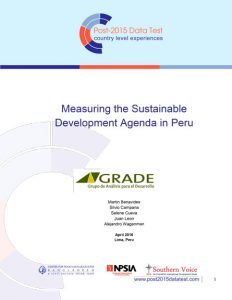Measuring the sustainable development agenda in Peru
| Año | : | 2016 |
|---|---|---|
| Autor/es | : | Martín Benavides, Silvio Campana, , Juan León, |
| Área/s | : | Etnicidad, género, ciudadanía y derechos, Pobreza y equidad |
In 2012, the Rio+20 United Nations Conference on Sustainable Development pledged that governments will propose a set of Sustainable Development Goals (SDGs) for the post-2015 period. The SDGs – agreed to in September 2015 – replace the Millennium Development Goals (MDGs), which expire in the same year. The SDGs take into consideration positive experiences from the MDGs and aspects that were excluded from or not achieved with the MDGs. Unlike the MDGs, the SDGs are universal in nature, applying to all countries. To contribute to ongoing discussions on the post-2015 agenda, Bangladesh’s Centre for Policy Dialogue (CPD) and Canada’s Norman Paterson School of International Affairs at Carleton University, in association with Southern Voice on Post-MDG International Development Goals, launched “The Post-2015 Data Test: Unpacking the Data Revolution at the Country Level,” an initiative to examine how the SDGs can be applied and monitored across low-, middle- and high-income countries. The initiative includes the mapping of available data to measure post-2015 sustainable development indicators and the identification of challenges and opportunities that countries may face during the implementation of the SDGs. This report presents the key findings of the Peru case study under the initiative.
The Group for the Analysis of Development (GRADE) is the multidisciplinary research institution responsible for the Peru case study. The study includes an examination of targets and indicators for roughly 12 of the 17 candidate SDGs, grouped into seven key areas: (i) poverty, (ii) education, (iii) employment and inclusive growth, (iv) energy and infrastructure, (v) environmental sustainability and disaster resilience, (vi) governance and (vii) global partnership for sustainable development. Furthermore, this report identifies the challenges for monitoring the SDGs and their respective policy implications and recommendations for the achievement of the SDGs in Peru.
As the finalised SGD document points out, “poverty eradication is the greatest global challenge facing the world today and an indispensable requirement for sustainable development” (UN 2015). This statement is particularly relevant for the Latin American region, including Peru, since it is one of the worst-rated regions in the world in terms of inequality. Although poverty rates continue to decrease, the probability of falling back into poverty will persist if inequalities based on gender, ethnicity and territorial factors remain.
To overcome these key challenges and produce real change in the lives of people, it is necessary to focus on the ones who have been “left behind” and have the least. In Peru, minorities (e.g., women, indigenous, AfroPeruvians) are the people who need the most attention. There is a need for more disaggregated data to better understand how these groups live and what they have, think and feel.
In this context, the report provides an analysis of SDG priorities for Peru and examines data availability for monitoring and following through on the SDGs at the country level. Furthermore, its comparative matrix of targets and indicators will be useful for policy-makers during their planning phase for implementing the SDGs at the national level. Additionally, the unpacking of the data revolution in Peru will be an excellent input that can help start the same process in other Latin American countries.






